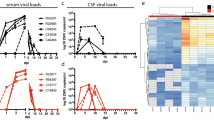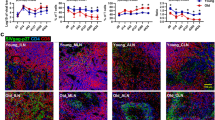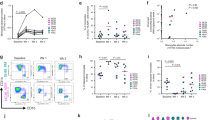Abstract
African primates are naturally infected with over 40 different simian immunodeficiency viruses (SIVs), two of which have crossed the species barrier and generated human immunodeficiency virus types 1 and 2 (HIV-1 and HIV-2)1,2. Unlike the human viruses, however, SIVs do not generally cause acquired immunodeficiency syndrome (AIDS) in their natural hosts3. Here we show that SIVcpz, the immediate precursor of HIV-1, is pathogenic in free-ranging chimpanzees. By following 94 members of two habituated chimpanzee communities in Gombe National Park, Tanzania, for over 9 years, we found a 10- to 16-fold higher age-corrected death hazard for SIVcpz-infected (n = 17) compared to uninfected (n = 77) chimpanzees. We also found that SIVcpz-infected females were less likely to give birth and had a higher infant mortality rate than uninfected females. Immunohistochemistry and in situ hybridization of post-mortem spleen and lymph node samples from three infected and two uninfected chimpanzees revealed significant CD4+ T-cell depletion in all infected individuals, with evidence of high viral replication and extensive follicular dendritic cell virus trapping in one of them. One female, who died within 3 years of acquiring SIVcpz, had histopathological findings consistent with end-stage AIDS. These results indicate that SIVcpz, like HIV-1, is associated with progressive CD4+ T-cell loss, lymphatic tissue destruction and premature death. These findings challenge the prevailing view that all natural SIV infections are non-pathogenic and suggest that SIVcpz has a substantial negative impact on the health, reproduction and lifespan of chimpanzees in the wild.
This is a preview of subscription content, access via your institution
Access options
Subscribe to this journal
Receive 51 print issues and online access
$199.00 per year
only $3.90 per issue
Buy this article
- Purchase on SpringerLink
- Instant access to full article PDF
Prices may be subject to local taxes which are calculated during checkout




Similar content being viewed by others
Accession codes
Data deposits
Newly derived SIVcpz sequences have been deposited in the GenBank database under accession numbers FJ895381–FJ895405.
References
Hahn, B. H., Shaw, G. M., De Cock, K. M. & Sharp, P. M. AIDS as a zoonosis: scientific and public health implications. Science 287, 607–614 (2000)
Sharp, P. M., Shaw, G. M. & Hahn, B. H. Simian immunodeficiency virus infection of chimpanzees. J. Virol. 79, 3891–3902 (2005)
Silvestri, G. Immunity in natural SIV infections. J. Intern. Med. 265, 97–109 (2008)
Koopman, G., Haaksma, A. G., ten Velden, J., Hack, C. E. & Heeney, J. L. The relative resistance of HIV type 1-infected chimpanzees to AIDS correlates with the maintenance of follicular architecture and the absence of infiltration by CD8+ cytotoxic T lymphocytes. AIDS Res. Hum. Retroviruses 15, 365–373 (1999)
Gougeon, M. L. et al. Lack of chronic immune activation in HIV-infected chimpanzees correlates with the resistance of T cells to Fas/Apo-1 (CD95)-induced apoptosis and preservation of a T helper 1 phenotype. J. Immunol. 158, 2964–2976 (1997)
Heeney, J. L. et al. Transmission of simian immunodeficiency virus SIVcpz and the evolution of infection in the presence and absence of concurrent human immunodeficiency virus type 1 infection in chimpanzees. J. Virol. 80, 7208–7218 (2006)
Santiago, M. L. et al. Foci of endemic simian immunodeficiency virus infection in wild-living eastern chimpanzees (Pan troglodytes schweinfurthii). J. Virol. 77, 7545–7562 (2003)
Keele, B. F. et al. Chimpanzee reservoirs of pandemic and nonpandemic HIV-1. Science 313, 523–526 (2006)
Schindler, M. et al. Nef-mediated suppression of T cell activation was lost in a lentiviral lineage that gave rise to HIV-1. Cell 125, 1055–1067 (2006)
Schindler, M. et al. Inefficient Nef-mediated downmodulation of CD3 and MHC-I correlates with loss of CD4+ T cells in natural SIV infection. PLoS Pathog. 4, e1000107 (2008)
Bailes, E. et al. Hybrid origin of SIV in chimpanzees. Science 300, 1713 (2003)
Goodall, J. The Chimpanzees of Gombe: Patterns of Behavior (Belknap, 1986)
Pusey, A. E., Pintea, L., Wilson, M. L., Kamenya, S. & Goodall, J. The contribution of long-term research at Gombe National Park to chimpanzee conservation. Conserv. Biol. 21, 623–634 (2007)
Wawer, M. J. et al. Rates of HIV-1 transmission per coital act, by stage of HIV-1 infection, in Rakai, Uganda. J. Infect. Dis. 191, 1403–1409 (2005)
Hill, K. et al. Mortality rates among wild chimpanzees. J. Hum. Evol. 40, 437–450 (2001)
Williams, J. M. et al. Causes of death in the Kasekela chimpanzees of Gombe National Park, Tanzania. Am. J. Primatol. 70, 766–777 (2008)
Pantaleo, G. et al. HIV infection is active and progressive in lymphoid tissue during the clinically latent stage of disease. Nature 362, 355–358 (1993)
King, N. W. Simian immunodeficiency virus infections. In Nonhuman Primates I (eds Jones T. C., Mohr, U. & Hunt, R. D.) 5–20 (Springer, 1993)
Pandrea, I., Silvestri, G. & Apetrei, C. AIDS in African nonhuman primate hosts of SIVs: a new paradigm of SIV infection. Curr. HIV Res. 7, 57–72 (2009)
Estes, J. D. et al. Early resolution of acute immune activation and induction of PD-1 in SIV-infected sooty mangabeys distinguishes nonpathogenic from pathogenic infection in rhesus macaques. J. Immunol. 180, 6798–6807 (2008)
Estes, J. D. et al. Simian immunodeficiency virus-induced lymphatic tissue fibrosis is mediated by transforming growth factor β1-positive regulatory T cells and begins in early infection. J. Infect. Dis. 195, 551–561 (2007)
Brocklehurst, P. & French, R. The association between maternal HIV infection and perinatal outcome: a systematic review of the literature and meta-analysis. Br. J. Obstet. Gynaecol. 105, 836–848 (1998)
Bhaskaran, K. et al. Changes in the risk of death after HIV seroconversion compared with mortality in the general population. J. Am. Med. Assoc. 300, 51–59 (2008)
Mulder, D. W. et al. Two-year HIV-1-associated mortality in a Ugandan rural population. Lancet 343, 1021–1023 (1994)
Hansmann, A. et al. Baseline plasma viral load and CD4 cell percentage predict survival in HIV-1- and HIV-2-infected women in a community-based cohort in The Gambia. J. Acquir. Immune Defic. Syndr. 38, 335–341 (2005)
Pusey, A. E., Wilson, M. L. & Collins, D. A. Human impacts, disease risk, and population dynamics in the chimpanzees of Gombe National Park, Tanzania. Am. J. Primatol. 70, 738–744 (2008)
Poulsen, A. G. et al. 9-year HIV-2-associated mortality in an urban community in Bissau, west Africa. Lancet 349, 911–914 (1997)
Ronquist, F. & Huelsenbeck, J. P. MrBayes 3: Bayesian phylogenetic inference under mixed models. Bioinformatics 19, 1572–1574 (2003)
Singer, J. D. & Willett, J. B. Applied Longitudinal Data Analysis: Modeling Change and Event Occurrence (Oxford Univ. Press, 2003)
Acknowledgements
We thank the field staff at the Gombe Stream Research Centre for collecting behavioural data as well as urine and faecal samples from wild chimpanzees; E. Kaaya for help with necropsies; A. Collins for logistical support; the Tanzania Commission for Science and Technology, the Tanzania Wildlife Research Institute, and the Tanzania National Parks for permission to conduct research in Gombe; I. White for discussions; L. Lowenstine for histological consultation; M. Salazar and Y. Chen for technical assistance; and J. C. White for artwork and manuscript preparation. This work was supported by grants from the National Institutes of Health (R01 AI50529, R01 AI58715, U19 AI067854, T32 GM008111), the National Cancer Institute (contract HHSN266200400088C), the UAB Center for AIDS Research (P30 AI 27767), the Yerkes National Primate Research Center (RR-00165), the National Science Foundation (DBS-9021946, SBR-9319909, BSC-0452315, IIS-0431141, BSC-0648481), the Jane Goodall Institute, the Harris Steel Group, the University of Minnesota, the University of Illinois, the US Fish and Wildlife Service Great Ape Conservation Fund, the Windibrow, Arcus, Guthman and Davee Foundations, and the Lincoln Park Zoo. R.S.R. was funded by a Howard Hughes Medical Institute Med-into-Grad Fellowship. The content of this publication does not necessarily reflect the views or policies of the US Department of Health and Human Services, nor does mention of trade names, commercial products, or organizations imply endorsement by the US Government.
Author Contributions All authors contributed to the acquisition, analysis and interpretation of the data; B.F.K., A.E.P., J.G., G.M.S., P.M.S. and B.H.H. initiated and conceived the study; B.F.K., R.S.R., Y.L. and E.W. performed non-invasive SIVcpz screening and genetic analyses; J.H.J., J.S.-S., M.L.W. and A.E.P. analysed chimpanzee fertility and mortality; K.A.T., M.J.K., J.R., D.A.T. and T.M. performed necropsies; K.A.T. and J.D.E performed immunohistochemistry and in situ hybridization studies; G.H.L. and P.M.S. performed phylogenetic analyses; J.H.J., T.M.B. and P.M.S. performed statistical analyses; M.L.W., A.M., S.K., E.V.L. and D.A.T. conducted and supervised all fieldwork. J.G.E. and G.S. provided data on captive sooty mangabeys; and B.F.K., A.E.P., P.M.S., G.M.S. and B.H.H. coordinated the contributions of all authors and wrote the paper. B.F.K., J.H.J., K.A.T., J.D.E., R.S.R. and M.L.W. contributed equally to this paper.
Author information
Authors and Affiliations
Corresponding author
Supplementary information
Supplementary Information
This file contains Supplementary Figures 1-5, Supplementary Tables 1-6, Supplementary Methods and Supplementary References. (PDF 4221 kb)
Rights and permissions
About this article
Cite this article
Keele, B., Jones, J., Terio, K. et al. Increased mortality and AIDS-like immunopathology in wild chimpanzees infected with SIVcpz. Nature 460, 515–519 (2009). https://doi.org/10.1038/nature08200
Received:
Accepted:
Issue Date:
DOI: https://doi.org/10.1038/nature08200



